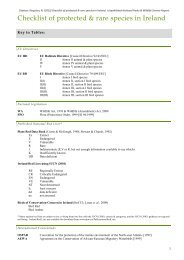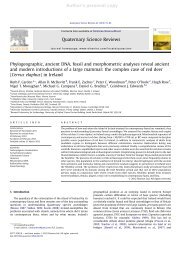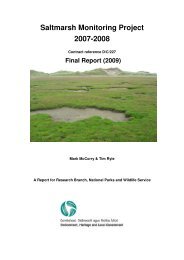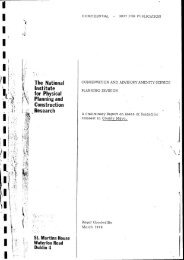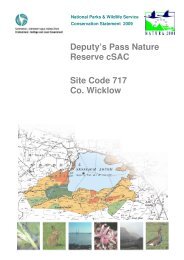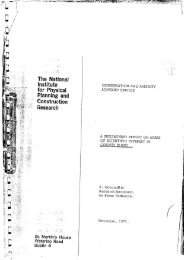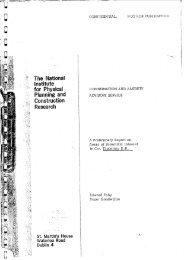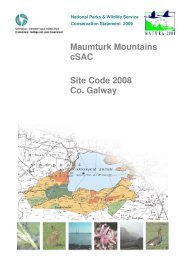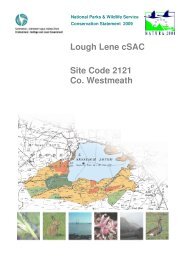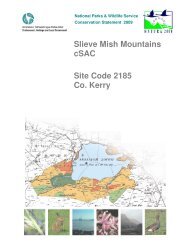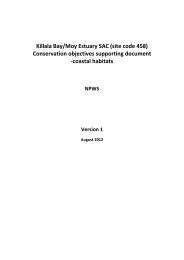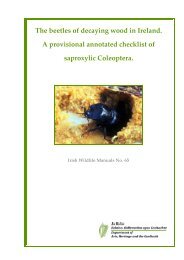The Role of Kelp in the Marine Environment - National Parks ...
The Role of Kelp in the Marine Environment - National Parks ...
The Role of Kelp in the Marine Environment - National Parks ...
You also want an ePaper? Increase the reach of your titles
YUMPU automatically turns print PDFs into web optimized ePapers that Google loves.
Several studies have demonstrated <strong>the</strong> importance <strong>of</strong> kelp as a food source. Dugg<strong>in</strong>s<br />
(1989) <strong>in</strong> a study <strong>of</strong> kelp beds <strong>in</strong> <strong>the</strong> Aletutian Islands found that 40 – 60 % <strong>of</strong> carbon<br />
found <strong>in</strong> coastal <strong>in</strong>vertebrates could be traced to kelp photosyn<strong>the</strong>sis. Fredrikson<br />
(2003) also showed that kelp (L. hyperborea) carbon was <strong>in</strong>corporated <strong>in</strong>to<br />
<strong>in</strong>vertebrates and birds <strong>of</strong>f Norway. Indirect evidence also shows <strong>the</strong> importance <strong>of</strong><br />
kelp <strong>in</strong> coastal ecosystems. Dugg<strong>in</strong>s et al. (op. cit.) showed that filter feeders grew<br />
considerably slower <strong>of</strong>f islands where <strong>the</strong> kelp forest had been destroyed by sea<br />
urch<strong>in</strong>s. Dugan et al. (2003) showed that biodiversity <strong>of</strong> birds and <strong>in</strong>vertebrates on<br />
sandy Californian beaches could be correlated with <strong>the</strong> quantity <strong>of</strong> drift kelp washed<br />
ashore and left to decay.<br />
As <strong>the</strong> total removal <strong>of</strong> <strong>the</strong> kelp forest not only removes it’s contribution to primary<br />
production but also destroys <strong>the</strong> habitat <strong>of</strong> many <strong>of</strong> <strong>the</strong> species which live on this<br />
production, it is difficult to separate <strong>the</strong> effect <strong>of</strong> remov<strong>in</strong>g a food source from that <strong>of</strong><br />
destroy<strong>in</strong>g a habitat. But as kelp primary production does not accumulate <strong>in</strong> <strong>the</strong><br />
ecosystem and it is so <strong>in</strong>tense relative to normal planktonic production, it is<br />
reasonable to assume that much <strong>of</strong> it is consumed by o<strong>the</strong>r species. This assumption<br />
is supported by <strong>the</strong> studies noted above.<br />
2. Available Substratum<br />
A. Flora<br />
All parts <strong>of</strong> kelps (holdfast, stipe and blade) function as substrata, and with <strong>in</strong>creas<strong>in</strong>g<br />
age <strong>of</strong> kelp plants <strong>the</strong> number <strong>of</strong> both <strong>in</strong>dividuals and species <strong>of</strong> kelp associated flora<br />
<strong>in</strong>creases significantly (R<strong>in</strong>de et al., 1992). <strong>The</strong> epiphytic flora, generally found on<br />
<strong>the</strong> stipes <strong>of</strong> Lam<strong>in</strong>aria hyperborea, comprises ma<strong>in</strong>ly red algal species, such as<br />
Palmaria palmata, Phyllophora spp. and Delesseria sangu<strong>in</strong>ea (Whittick 1983).<br />
Along with <strong>the</strong>se leafy species, a substantial number <strong>of</strong> filamentous, branched species,<br />
such as Polysiphonia and Ceramium species, and corall<strong>in</strong>e encrust<strong>in</strong>g algae, such as<br />
Lithothamnion spp., can also be found.<br />
No peer-reviewed studies have been carried out <strong>in</strong> Ireland on <strong>the</strong> epiflora specifically<br />
associated with kelp even though its physical structure provides a perfect and<br />
convenient sampl<strong>in</strong>g unit that can be aged and measured with some degree <strong>of</strong><br />
26



